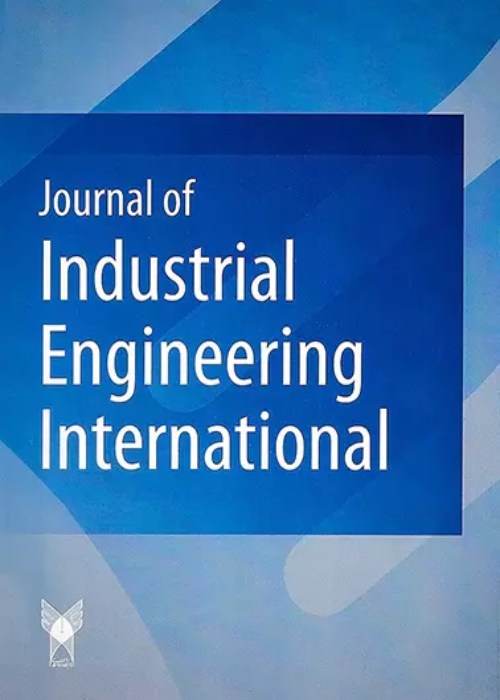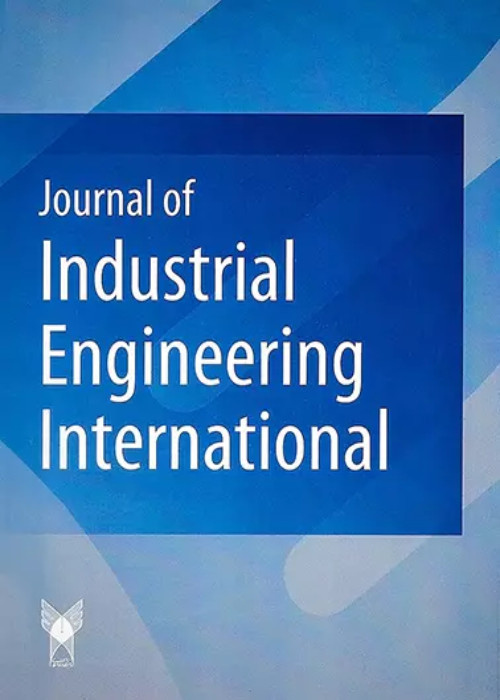فهرست مطالب

Journal Of Industrial Engineering International
Volume:18 Issue: 4, Autumn 2022
- تاریخ انتشار: 1402/08/17
- تعداد عناوین: 7
-
-
Pages 1-18
In this research, the problem of designing a logistics hub network to improve flow management in the implementation of global transport operations has been investigated. In this case, shipments can be moved directly or indirectly between points. In indirect shipping mode, the shipment first enters the hub network and then is sent to customers. In this case, there is a certain discount factor that reduces the time it takes for the product to reach end customers. The objective function of the proposed model is to minimize the fixed costs of constructing a hub, the cost of constructing an inter-hub infrastructure, the cost of transportation if the equipment is transported directly, and the cost of transportation if the hub network is used. The limitations of the model also include locating logistics hubs, managing flow between points, calculating transport time, and finally managing flow between network points. To evaluate the performance of the proposed model, a researcher-made numerical example based on real-world conditions with randomly generated data and sensitivity analysis on the problem outputs was performed. According to the results, it can be seen that the proposed model can produce justified and optimal global answers and therefore can solve real-world problems. Also, based on the sensitivity analysis, it can be seen that with increasing the amount of capacity, the values of the target function decrease. In other words, if capacity is increased, there is a need for fewer vehicles and thus costs are reduced. It is also clear that as capacity increases, the number of vehicles to respond to decreases. In fact, the greater the carrying capacity, the easier it is to manage the flow between the hubs as well as the direct transmission, thus reducing the number of vehicles. In addition, as the cost of building infrastructure increases/decreases, the cost of the entire system is affected.
Keywords: location, global logistics, hub network design, time discount coefficient -
Pages 19-27
Attracting customers and keeping market share have become more important for manufacturers in today’s competitive market. Offering warranty for their products is one of the techniques that manufacturers use to attract customers. There are different types of warranty policies. Most research in this area has focused on two-stage warranties and little attention has been paid to three-stage warranties. Hence, in this study, a three-stage non-renewing warranty is investigated in which, the length of warranty period is divided into three phases. In the first phase, if the product fails, the cost of repair is fully covered by the manufacturer. In the next phase, if failure happens, most of the repair cost is still covered by the manufacturer while the customer must pay for the rest of it. Finally, in the third phase, if the product faces any failure, most of the repair cost is paid by the customer as the product has been used for quite some time by then. In this study, a repairable system under this type of warranty policy is investigated and warranty cost during this period is derived. To minimize the cost of warranty period, the optimum length of each phase is obtained. Numerical examples are provided to verify the proper performance and applicability of the proposed model.
Keywords: Warranty Cost, Three-stage warranty, Optimization -
Pages 28-43
Technology transfer helps create innovation and manufacture new products in developing countries, and the identification of major success factors in technology transfer could help obtain competitive advantages. The present study mainly aims to develop the main success factors in technology transfer in the oil industry of Iran. This study is applied research and adopts a descriptive-correlational methodology. The statistical population consisted of 149 oil industry experts at National Iranian Oil Company and its subsidiary companies. The sample size was found to be 107 based on Cochran’s formula, and the respondents were selected through random sampling to respond to the validated questionnaires. The main success factors in technology transfer in the oil industry were identified and confirmed by reviewing the literature and implementing exploratory and confirmatory factor analyses. A total of eleven factors were identified, including technology owner characteristics, strategic factors, technology characteristics, political factors, economic factors, management factors, sociocultural factors, human resources, legal factors, infrastructures, and environmental factors, of which technology owner characteristics, strategic factors, technology characteristics, management factors, sociocultural factors, human resources, and environmental factors were the main technology transfer success factors in the oil industry.
Keywords: Technology transform, Success factors, Exploratory factor analysis, Confirmatory factor analysis, Iranian oil industry -
Pages 43-78
In recent years, increasing carbon emissions and relatively unfavorable climate change have led to paying attention to the concepts of sustainability as well as the imposition of strict government regulations on manufacturers and service providers. This has caused all parts of society, containing consumers, governments, and companies, to pay greater attention to low-carbon manufacturing in the supply chain (SC). To this end, this paper has designed a sustainable, multi-echelon, multi-product, multi-period, and multi-objective closed-loop supply chain (CLSC) network, with different distribution and collection channels and Radio Frequency Identification (RFID) technology, in addition, in order to produce low-carbon products, low-carbon products and subsidizing policies, and also deals with pricing strategy. This model, at the same time, maximizes profits and the social responsibility of the SC network, while it minimizes the overall delay in delivery time and environmental pollution. To cope with the parameters' uncertainty, a Robust scenario-based Stochastic programming (RSSP) approach has been used, and to solve and validate, the small-size model the Augmented Epsilon Constraint (AEC) method, and to solve large-sized ones, the third edition of the Non-dominated Sorting Genetic Algorithm (NSGA-III) and Multi-Objective Grey Wolf Optimizer Algorithm (MOGWO) are used. According to the computational results, the suggested model can provide efficient decisions and the MOGWO algorithm yields 14.5% improvement in execution time compared to the NSGA-III algorithm. Also suggested model can be a great tool for managers and professionals with a wide range of strategic applications.
Keywords: - Government Subsidy, Low-Carbon, Multi-Channel Closed-Loop Supply Chain, Pricing, Radio FrequencyIdentification technology -
Pages 80-101
Most cooperative advertising works assume that subsidy is usually given directly to the retailer. This work addresses a three-level supply chain setting where advertising subsidy is transferable from the manufacturer to the retailer through the distributor, together with a situation where both the retailer and the distributor directly engage in advertising. The parties in the channel are considered to play an infinite horizon Stackelberg differential game with the manufacturer as the leader, and the distributor and the retailer as the first and the last followers respectively. The work studies the effect of subsidy on the players’ profits in a four-channel setting where both the manufacturer and the distributor do not subsidise advertising; the manufacturer’s provided retail subsidy is not transferred to the retailer; the distributor provides retail subsidy without the manufacturer’s involvement; and the distributor transfers the manufacturer’s provided subsidy to the retailer. It determines the players’ optimal advertising efforts, subsidy policies, and profits for the four channel settings. It also obtains the players’ appropriate subsidy limits. The work shows that the channel profits are best with the distributor’s participation, followed by transfer of subsidy setting, and worst with non-provision of subsidy by both manufacturer and distributor.
Keywords: Cooperative advertising, differential game, subsidy rate, Stackelberg game, supply chain -
Pages 102-114
Flexible job-shop scheduling problem (FJSP) finds significant interest in the field of scheduling in dealing with complexity, solution methodology and, industrial applications. However, most of the studies on FJSP, consider the processing time of operations to be deterministic and known at priori while solving the problem. Since uncertainty is bound to occur in industries, deterministic approaches for solving FJSP may not yield good solutions. Schedules generated considering uncertainties may help the manufacturing firms to handle the uncertainties efficiently. The present work aims at solving FJSP in a realistic manner, considering uncertainty in the processing times. A modified version of optimization algorithms without tuning parameters such as teaching-learning-based optimization (TLBO) and JAYA is proposed to solve fuzzy FJSP (FFJSP) with less computational burden. Although there are enough challenging benchmark problems for deterministic FJSP problems, only limited benchmarks are available for a fuzzy variant of FJSP. The currently available FFJSP problems in the literature are small in size as compared to Brandimate data instances which are widely accepted for a deterministic variant of FJSP. Therefore, an attempt has been made in this paper to solve the instances of Kacem’s and Brandimarte’s by converting them into fuzzy FJSP. The present work also provides new challenging problems compared to the existing benchmark problems to study FFJSP.
Keywords: Flexible job-shop scheduling problem, JAYA, processing time’s uncertainty, TLBO, triangular fuzzynumbers -
Pages 115-129
The Flare Gas Recovery System (GR) is a critical component in preventing the release of pollutants into the atmosphere. However, these systems are expensive to install and maintain, so ensuring their reliability and effectiveness during operation is critical task. Two safety system technologies have been developed for GR, the fast opening and closing valve system (OVS) and the closed drum system (CDS), but the dynamic operating conditions and lack of historical data make reliability estimates as a crucial complicated task. To address this issue, we propose a novel approach to develop a system reliability as a response surface based on multiple operating pressure and temperature using a hybrid fault tree and a fuzzy inference system. The result reveals an average 22.4% improvement in reliability for OVS compared to CDS in various operational scenarios. Our proposed method provides an operative technique to assess the reliability of GR security systems considering various operating conditions. Results also can help decision-makers to choose the security technology that best fits their particular application needs, ultimately reducing maintenance of costs while ensuring optimal performance over the long term.
Keywords: Reliability assessment, Flare gas recovery system, Fault tree analysis, Fuzzy inferencesystem, Expert elicitation


